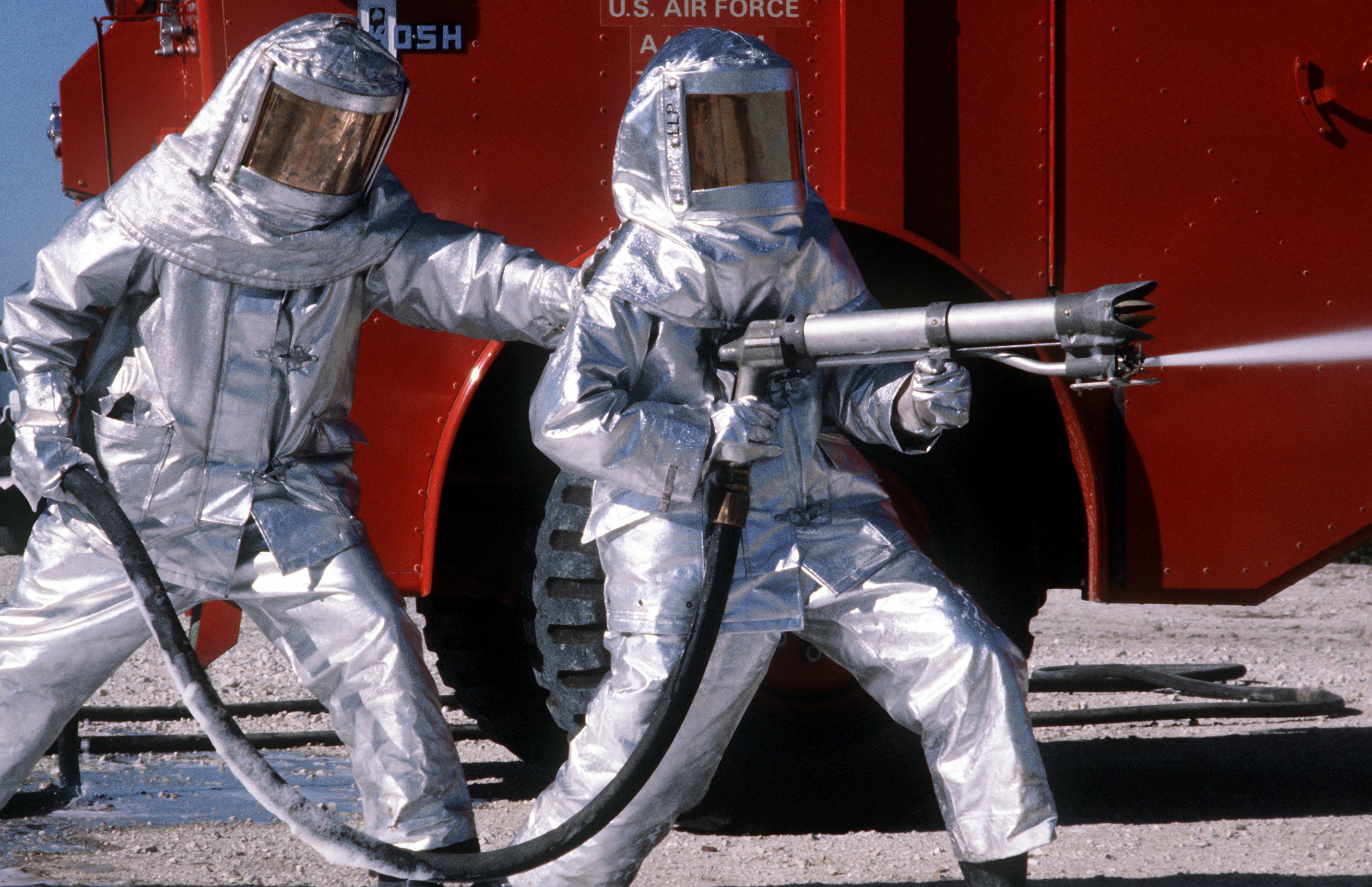|
Fire Proximity Suit
A fire proximity suit (also, silvers, silver bunker suit, or asbestos suit) is a suit designed to protect a firefighter or volcanologist from extremely high temperatures. They were first designed and used in the 1930s. Originally made of asbestos fabric, current models use vacuum-deposited aluminized materials. History Fire proximity suits first appeared during the 1930s, and were originally made of asbestos fabric. Today they are manufactured from vacuum-deposited aluminized materials that reflect the high radiant loads produced by the fire. An early manufacturer of the aluminized suits was the Bristol Uniforms company under of Patrick Seager Hill. Types There are three basic types of these aluminized suits: * Approach suit—used for work in the general area of high temperatures such as steel mills and smelting facilities. These usually provide ambient heat protection up to ≈. * Proximity suit—used for aircraft rescue and fire fighting (AR-FF) and, in more heavily ... [...More Info...] [...Related Items...] OR: [Wikipedia] [Google] [Baidu] |
Fire Fighters Practice With Spraying Equipment, March 1981
Fire is the rapid oxidation of a material (the fuel) in the exothermic chemical process of combustion, releasing heat, light, and various reaction Product (chemistry), products. At a certain point in the combustion reaction, called the ignition point, flames are produced. The ''flame'' is the visible portion of the fire. Flames consist primarily of carbon dioxide, water vapor, oxygen and nitrogen. If hot enough, the gases may become ionized to produce Plasma (physics), plasma. Depending on the substances alight, and any impurities outside, the color of the flame and the fire's Intensity (heat transfer), intensity will be different. Fire in its most common form can result in conflagration, which has the potential to cause physical damage through burning. Fire is an important process that affects ecological systems around the globe. The positive effects of fire include stimulating growth and maintaining various ecological systems. Its negative effects include hazard to life and pr ... [...More Info...] [...Related Items...] OR: [Wikipedia] [Google] [Baidu] |
Zetex (fabric)
Zetex fabrics were invented by Bal Dixit in 1978. This highly texturized fiberglass fabric exhibits many of the same properties as asbestos, such as resistance to heat, corrosion and rot resistance, outstanding electrical properties, ability to withstand molten metal, and thermal insulation. However, it does not carry the same health risks. Testing Zetex has been tested against asbestos to prove it is a good replacement. Two Zetex filaments were created, one with a 9 um diameter (G) and a 6 um diameter (DE). Physical Properties Chrysotile, the most commonly encountered form of asbestos, has a density of 40 oz/yd2, while Zetex G has a density of 35 oz/yd2, and Zetex DE has a density of 32 oz/yd2. Other physical properties are listed in the table below: Temperature rise testing A glove was fabricated from this material to allow for further testing to be done. A thermocouple was used to test the inside temperature of the glove while holding a 600°F(316°C) pipe. A measure was ta ... [...More Info...] [...Related Items...] OR: [Wikipedia] [Google] [Baidu] |
Fire Protective Clothing
Fire is the rapid oxidation of a material (the fuel) in the exothermic chemical process of combustion, releasing heat, light, and various reaction products. At a certain point in the combustion reaction, called the ignition point, flames are produced. The ''flame'' is the visible portion of the fire. Flames consist primarily of carbon dioxide, water vapor, oxygen and nitrogen. If hot enough, the gases may become ionized to produce plasma. Depending on the substances alight, and any impurities outside, the color of the flame and the fire's intensity will be different. Fire in its most common form can result in conflagration, which has the potential to cause physical damage through burning. Fire is an important process that affects ecological systems around the globe. The positive effects of fire include stimulating growth and maintaining various ecological systems. Its negative effects include hazard to life and property, atmospheric pollution, and water contamination. If fire re ... [...More Info...] [...Related Items...] OR: [Wikipedia] [Google] [Baidu] |

